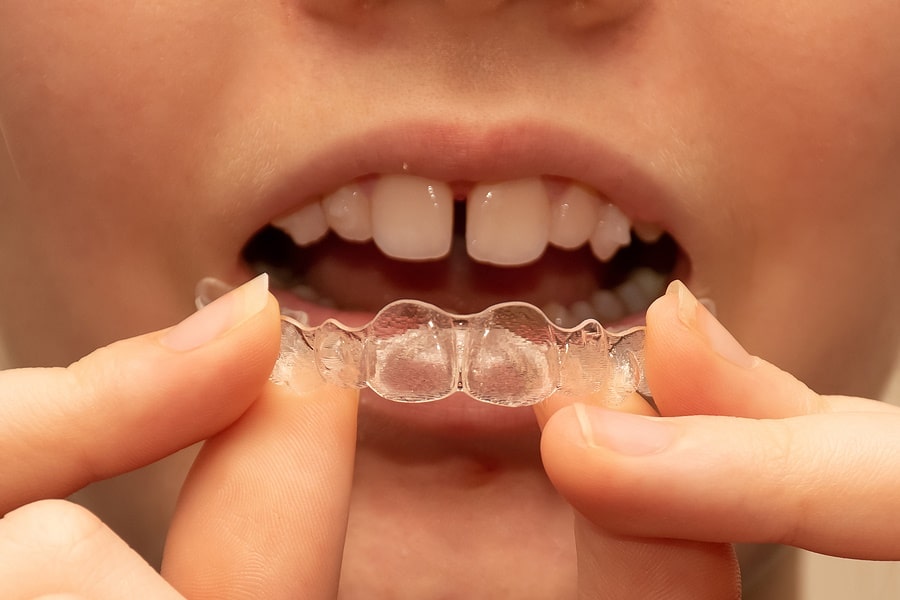Leading Reasons to Select Invisalign Over Other Orthodontic Treatments
Leading Reasons to Select Invisalign Over Other Orthodontic Treatments
Blog Article
Invisalign vs. Typical Braces: Which Choice Is Right for You?
When thinking about orthodontic treatment, the choice between Invisalign and conventional braces provides a number of important aspects that warrant mindful examination. Invisalign offers a very discreet alternative with detachable aligners, while conventional dental braces offer an extra noticeable yet effective option for severe imbalance. Each choice encompasses unique benefits and drawbacks connected to aesthetics, comfort, treatment duration, and cost. Understanding these nuances is essential for making an informed decision that aligns with your individual preferences and lifestyle. The question remains: which option will ideal satisfy your orthodontic needs and expectations?
Review of Treatment Alternatives

On the other hand, conventional braces include metal braces and cords that are adhered to the teeth. This approach applies continuous pressure in time to attain placement. While effective for intricate orthodontic issues, conventional braces need normal brows through for modifications and can posture difficulties in maintaining dental health due to the trouble of cleansing around brackets and cables.
Both alternatives have their merits, and the choice typically depends upon particular oral conditions, way of living preferences, and person conformity. Inevitably, getting in touch with an orthodontic professional is important for determining one of the most ideal treatment plan customized to specific needs. Comprehending the nuances of each choice can significantly influence the total success of orthodontic treatment.
Visual Considerations
A considerable element influencing the choice between Invisalign and standard dental braces is the visual appeal each treatment supplies. Invisalign aligners are crafted from clear plastic, making them essentially undetectable when used.
On the other hand, traditional braces are composed of metal brackets and cords, which can be much more recognizable. While developments in orthodontic modern technology have caused the development of smaller braces and colored elastics, traditional braces still preserve a more obvious account. For some individuals, the visibility of braces may prevent them from seeking necessary therapy.
Inevitably, the option in between Invisalign and conventional braces might pivot on personal preferences pertaining to aesthetics. Individuals who focus on discernment usually favor Invisalign, while those who are much less worried regarding exposure might choose for conventional braces. Understanding the aesthetic implications of each choice is vital for making an informed decision that straightens with one's way of life and choices.
Convenience and Convenience

In terms of comfort, Invisalign aligners are removable, allowing individuals to enjoy their preferred foods without limitation and preserve ideal dental hygiene. Brushing and flossing are simplified, as the aligners can be secured throughout these regimens, whereas conventional braces require careful navigating around cords and brackets.
In contrast, typical dental braces require normal changes, making them less practical for those with busy routines. Generally, the comfort and convenience of Invisalign make it an enticing selection for many individuals seeking orthodontic treatment.
Treatment Duration and Performance
While both Invisalign and traditional braces are reliable in correcting oral imbalances, the duration of treatment can differ substantially between the 2 choices. Usually, Invisalign therapy can take anywhere from 12 to 18 months, depending on the intricacy of the instance. The clear aligners function by gradually changing teeth into their desired positions, and regular follow-ups with an orthodontist help make certain development remains on track.
On the other hand, conventional braces frequently require a longer dedication, usually varying from 18 months to 3 years. This is because of their fixed useful source nature and making use of braces and cables, which can be extra efficient for severe imbalances and complicated cases (Invisalign). The therapy efficiency of traditional dental braces is well-documented, as they enable for exact modifications and greater control over tooth motion
Inevitably, the option between Invisalign and standard braces might pivot on both the anticipated treatment period and the particular dental concerns available. Consulting with an orthodontist is vital, as they can supply customized suggestions based upon private needs, making certain the picked technique aligns with preferred outcomes and timeframes.
Cost Comparison and Insurance Coverage Choices
Cost plays a substantial duty in the decision-making procedure for individuals taking into consideration orthodontic therapy, whether selecting Invisalign or standard braces. On average, the cost of Invisalign arrays from $3,000 to $8,000, while conventional braces generally set you back between $2,000 and $6,000. Aspects influencing these costs consist of the intricacy of the situation, the period of treatment, and geographical location.
Insurance protection can dramatically impact out-of-pocket expenses. Lots of oral insurance policy plans supply partial protection for orthodontic therapies, however the specifics can differ widely. It is essential for individuals to examine their insurance plan to identify the degree of coverage for either choice. Generally, typical braces may be a lot more often covered by insurance policy plans contrasted to Invisalign, which some insurance companies categorize as an aesthetic procedure.
Furthermore, a number of orthodontic methods supply flexible payment plans, making both therapy choices much more easily accessible. Individuals should ask about potential financing alternatives and discounts for upfront payments. Assessing the overall cost, consisting of insurance advantages and layaway plan, is essential for making a notified decision that straightens with both aesthetic choices and budget factors to consider.

Verdict
In summary, the option between Invisalign and typical braces depends upon multiple factors, including visual choices, comfort, therapy duration, and price. Invisalign offers a very discreet, detachable alternative that helps with dental health and nutritional flexibility, while standard braces may be extra ideal for intricate oral problems and frequently come with a reduced rate factor. Eventually, assessment with an orthodontist is necessary to analyze private scenarios and determine the most ideal therapy option for achieving optimal oral alignment.
When taking into consideration orthodontic treatment, the choice between Invisalign and typical braces offers several crucial elements that merit mindful go assessment.Contrasting Invisalign and conventional braces discloses click here for more distinct therapy choices for orthodontic improvement.While both Invisalign and standard braces are reliable in dealing with dental misalignments, the period of therapy can differ substantially in between the two options.Cost plays a substantial function in the decision-making procedure for individuals thinking about orthodontic therapy, whether choosing for Invisalign or conventional braces.In recap, the selection between Invisalign and traditional dental braces hinges on multiple aspects, consisting of aesthetic choices, convenience, therapy duration, and price.
Report this page